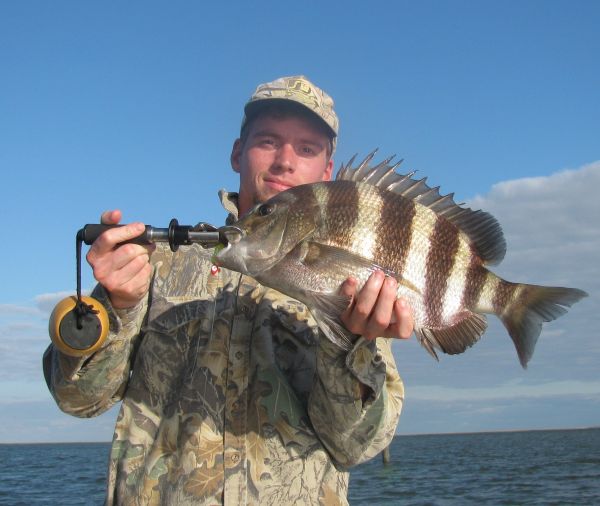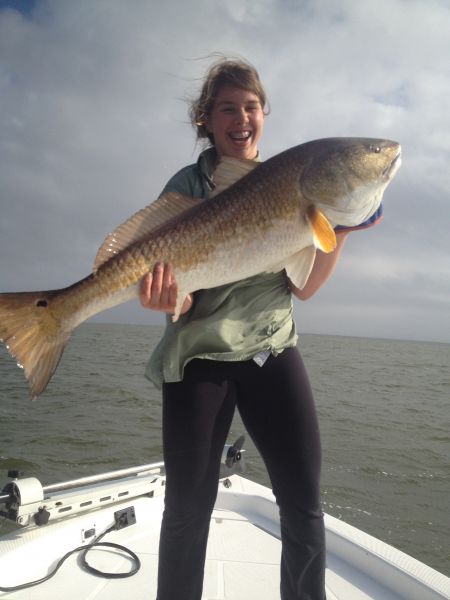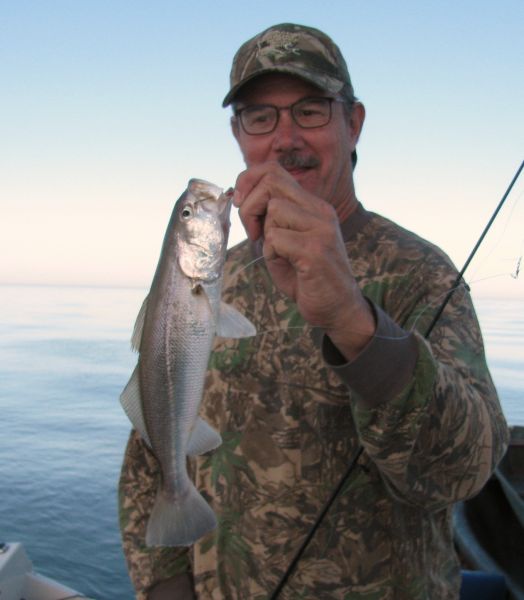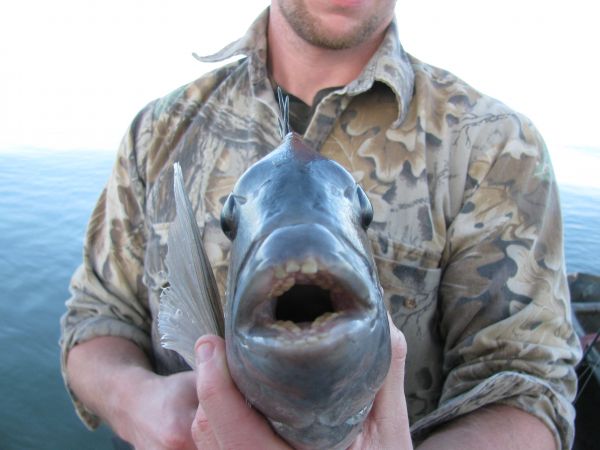Don’t worry about extreme low tides and marsh-emptying north winds: Head to this Southeast Louisiana collection of platforms to mop up on delectable sheepshead. Guaranteed.
The sheepshead ceviche was going even faster than the 4-point fajitas at Doc’s post-Endymion bash.
But few noticed: We were all focused on the “discussion” between Pelayo and Spence that had been triggered by Pelayo’s little sign on the buffet table unabashedly advertising his “4-POINT FAJITAS.”
Spencer and some of Pelayo’s other “partners” in the “trophy deer club” were not amused.
“Well, I ain’t saying ya ain’t a good farmer, Spence,” Pelayo snickered. “In fact, your food plots are veritable works of art — the rows are perfectly symmetrical and they grow lushly.
“And I ain’t saying ya ain’t a good rancher: Your doe ‘culling’ and let-him-walk ‘harvest’ policy will probably grow a healthy and balanced herd — sooner or later.
“And I ain’t saying ya ain’t a good photographer, Spence. Your game cams are positioned expertly and take some gorgeous shots.
“And I ain’t saying ya ain’t an expert architect and carpenter. Your box stands deserve a feature in Architectural Digest — and are plenty comfy.
“I’m just sayin I’m a better hunter, amigo. Comprende? The deer in those fajitas was actually hunted. His trails and rubs were revealed during diligent scouting. Then he was ‘harvested’ (Pelayo snickered obnoxiously while stressing that term) — from a climber in hellish thickets of a thick swamp while he browsed on natural foods.”
A small and attentive crowd had gathered during Pelayo’s discourse, watching as Pelayo snickered and Spencer’s faced twitched spastically, his lips tightening gritted teeth.
But instead of exploding in rebuttal, Spencer merely turned and walked to the balcony to brood silently with Doc.

“Whooh!” Eddie sighed as he looked over. “That was close!”
A long table featured everything from a shrimp mold to marinated veggies to buffalo wings to a dozen wine bottles. But the biggest line formed behind the ceviche, which most of the guests assumed was made from either specs or reds.
Amazingly, for many —probably most — locals, no other fish seems to exist in Louisiana’s coastal waters. None that’s worth targeting, that is.
“Hard-fighting! Tastes great!” “Hard fighting! Tastes great!”
Remember the old Miller Light commercials (“Less filling. Tastes great”)? Remember how they featured such folks as Boog Powell, Rodney Dangerfield, Bob Eucker and even Louisiana’s own Grits Gresham?
Well, after the little spat, some of the gang scooping greedily into the ceviche platter got to heatedly “discussing” the merits of sheepshead, employing the old Miller Lite chant.
And both made very valid points.
Take a bluegill, for instance. Most of us marvel that a fish that so small can fight so hard. Its design probably has much to do with it. By turning at a right angle to the line, the little fish increases the resistance. Throw in those powerful lunges of theirs, and you’re talking an absolute blast when you get on a bed of them.
Well, imagine a 4-pound bluegill: That’s about what you get from a sheepshead. A brutal back and forth slugging match punctuated with powerful runs that make you think it might be an 8-pound speck instead of a 3 1/2-pound sheepshead.
So yes: “Hard-fighting” certainly applied.
And the frenzy at the ceviche platter certainly confirmed the second half of the chant.
A fishing trip was planned in the next few days for the Quarantine Bay area with Artie’s visiting cousins, Becky and Glenn. Back home in North Carolina, they “dabbled in a little fishing,” they explained. But weren’t true fanatics about it, like us.
Alas, the tide was super low from a recent front, and the water was super-dirty from a high river coupled with three days of blustery east winds.
So the prospects of speck and redfish action from Deep Water Point up to California Point (the traditional quest when fishing this area, and what Doc had planned) looked dismal.
But the trip had been planned for two weeks and the guests were leaving the following day.
“The show must go on,” Doc insisted.
“Don’t worry,” Pelayo told a puzzled Becky and Glenn. “We’ll load the boat.”
The guests quickly became delighted and intrigued with his prediction, his attitude, and especially with his wide and confident smile.
“You’re going home with a ton of gorgeous, thick, white fillets — and from the same fish you’d been raving about all evening,” Pelayo laughed. “Been watching you hog the ceviche platter over there, right?”

“Oh yes!” Becky replied. “Delicious! Had it often in restaurants, especially in Cancun and on our cruises. But never this good!”
She smiled, while stuffing another heaping cracker past her bright red lips. “YUMMMM!” Becky exclaimed.
“Well, it’s sheepshead from last week’s trip to the very area we’re hitting tomorrow,” Pelayo said. “So get ready for rollicking action and serious eats!
“But ceviche is just one of the many delicious ways we prepare this white-fleshed, firm-fleshed and tough-fighting fish. And this is the time of the year to load up on em. You’ll see. You’ll have fishing action like you’ve probably never had in your life! The action tomorrow will shame anything and everything you’ve ever experienced on all those late-winter speck trips with Doc, where you crank in a small, mushy-meated, cold-stunted, feeble-fighting fish that barely bends your rod. You’ll see!”
It turns out that up in North Carolina (like everywhere along the Atlantic coast) sheepshead are highly prized as both sport and food fish. So Doc’s cousins were really pumped.
Since they’re usually treated to speck trips with plastic baits when visiting Louisiana, it hadn’t occurred to them that sheepshead were also available here by changing fishing tactics. They were in for a rude — and rollicking — awakening.
“Unlike most locals,” Pelayo continued explaining to Doc’s cousins, “this is one of our favorite times of the year to fish. Even the gals love going this time of the year. They say it’s catching rather than fishing.”
Pelayo pointed with his chin at “Da Real Housewives of Kennah,” as they call themselves over in the corner.
“Go ahead, ask ’em about our late-winter sheepshead trips. You’ll see,” he said.
“Da Real Housewives of Kennah,” (surprisingly) all smiled and nodded back in perfect agreement.
“They must be up to something,” a suspicious Pelayo leaned over and whispered. “Probably want us out of the way. Probably planning a trip to the ka-seeee-nah.”
(Turned out-he was right.)
Doc and Spence were really glaring at Pelayo now. They still planned a speck trip.
But the run of fat specks in that area usually kicks-in a couple months later, around April. Doc, however, had already drawn the plans: The die was cast.

Fine, we’d go through the motions of getting skunked by trout first; futilely casting into muddy water in a slack tide around Raccoon and California points. Then, when they were satisfied with the effort, we’d (hopefully) head out a few short miles to Battledore for Plan B.
Interestingly, “Battledore” once referred to a reef. Now it usually refers to a set of shallow rigs and wellheads just northeast of Quarantine Bay, usually accessed through the Ostrica locks.
Whoops! Here’s yet another historic term that’s changing with the times: Nowadays, most of us fish the Quarantine Bay area east of Empire by cutting through the natural cut just below the actual mechanical Ostrica locks and into the Quarantine Bay area.
Whatever. It’s a short easy trip, especially by launching into the river itself right across the locks in Buras.
Be warned, however, that this back-down ramp is a crude one. Bigger boats usually do better launching at Empire itself, and crossing through the locks into the river and hanging a right for the 4 1/2-mile run to Ostrica. Nothing to it.
The same slack tide that makes for lousy inside fishing would make for ideal sheepshead fishing at these structures. These fish like to really hug the pilings, you see. Often it’s important to get the bait right next to it; a ripping current won’t allow this, carrying your bait crucial yards away from the vital sheepshead strike zone.
Not that they actually strike. Instead they usually nibble.
Their popular moniker of “striped bandit” hails from their proficiency at stealing bait by nibbling with those Morgus the Magnificent teeth of theirs.
But this time of the year, with the spawn on, they’re hardly bashful about gulping bait. The nibbles feel like a series of mini-strikes.
One, two — WHAM! The rod bows and the battle is joined.
It was 10:30 a.m. two days later when we cleared the pilings marking most of the way across Quarantine Bay, continued a dew short miles and hooked up to a little rig in the Battledore area.
Much to our relief, Doc and Spence had looked at the weather, tides and river levels and bugged out.
“Perfect!” Pelayo snickered when he conveyed the news.
Not that we had to be at these structures. You see, this time of year, all shallow-water rigs (15 to 40 feet) off the Louisiana coast swarm with sheepshead. If you can get out the mile or two it usually takes, you’ll load up.
It’s that simple.
The sheepshead are spawning. So they’re ravenous and stacked up around shallow rigs and wellheads from Black Bay down through Breton Sound, East Bay, West Bay, Sandy Point, Grand Isle blocks, Bay Marchand blocks (Fourchon rigs) to Ship Shoal.
So load the boat with the kids, the wives, the sisters-in-law, the aunts — whoever likes catching more than fishing, and prepare for a blast of a fishing trip.
And a chunk of market shrimp on a jighead dropped near a rig leg is the only hocus-pocus required for instant and constant action.
It took barely a 10-minute open-water ride to hook up to the platform standing in 15-foot depths. And it didn’t take two minutes before Becky was screeching from the bow, her face in half-laugh, half-grimace mode as she grabbed the medium-action spinning rod a foot above the reel and cranked away spastically.
“I can’t!” she gasped. “HELP!”

Her rod tip jerked into the very water.
“Humberto! Pelayo! Glenn! HELP!” Becky cried.
“Just hold on!” Pelayo laughed, while grabbing her by the belt from behind. “He probably won’t pull you overboard. Think it might be a speck?”
“NO WAY!” She laughed. “Those things barely ….”
Becky jammed the rod butt between her legs and cranked awkwardly, using the gunwale as a rest for her bucking pole while her drag screeched crazily.
After much grunting, whooping and yelling, Becky’s fish was finally thrashing at boatside. Pelayo grabbed the leader and swung the chunky sucker aboard.
No time for landing nets with this type of fishing. We like 30-pound mono shock leaders about 3 to 4 feet long atop the jigs so we can reach down and swing these suckas in — one after another.
Glenn was still getting situated, munching on chips and chugging on drinks. I kept my eye on him as I finished my “roast-Bambi po-boy,” gulped my drink and finally rigged up my pole with 4 feet of 30-pound leader atop a 3/8-ounce jighead that I prepared to “sweeten” with maaaw-ket bait.
That’s it. That’s all it takes.
But even as I cast and Pelayo rigged up his rod, Glenn just stood there, waiting for those taps we’d assured him would come almost instantly — but didn’t seem to materialize?
“Hummmmmm?” I thought while looking over at Glenn, then at Pelayo — while shrugging.
He’d cast away from the rig, you see. And his shrimp-tipped jig had actually made it to the bottom. If he’d cast close to the structure, sheepshead usually don’t allow this.
“Just reel it back in slowly, bumping it” Pelayo suggested.
And, sure enough, not five cranks into Glenn’s retrieve — WHAM!
“OH YEAH!” he yelled. “Ga-ron-tee this ain’t no spec!”
(Glenn was a Justin Wilson fan from way back.)
“Probably not a sheepshead, either” Pelayo added. “Those runs are too long. Sheepshead usually slug it out with back-and-forth lunges.”
Indeed, a few minutes later I netted Glenn’s red — a borderline bull.

Glenn’s next cast away from the rig yielded a perfectly sized puppy drum, and the following three yielded white trout.
All delicious, all tough-fighting — all mostly shunned by our coastal fishermen.
Pelayo and I finally baited up our plain 3/8-ounce jigheads with shrimp, and swung our baits out.
With a slack current, we might go with 1/4-ounce jigheads. The key is to keep the bait as close as possible to the piling. With a strong current, this is often easier a mere 4 or 5 feet from the surface, and it amounts to a saltwater version of cane-pole perch jerking or sac-a-lait jigging around stumps.
I was just flipping the bail when — WHAM! The battle was joined.
The fish hit the shrimp-tipped jig not 5 feet from the surface, but my drag was loose (set for specks) so he started stripping out line like a maniac.
Sometimes, to vary it up, we’ll even use a cork, about 4 feet over the jig. “Popping corks for rig fishing?” you gape.
Well, there’s something about watching a cork plunge that just adds to the fishing thrill for some of us. Plus, with a cork the bait lands and remains in the crucial strike zone longer.
We fished one rig and two well jackets, and filled two boxes (like in the good-ol’ days).
here really isn’t much hocus-pocus to this type of fishing, amigos. Just get the shrimp-tipped jig head over the side and as close to the structure as possible. The sheepshead usually hang at mid- to upper depths rather than on the bottom.
So the fishing often resembles “flipping and jigging” for bass in the Venice canes or for sac-a-lait in mid-depths of a pond or lake.
I’d venture that a rig-caught winter sheepshead actually beats a deep-marsh redfish as table fare. The saltier the water, the better-tasting the fish.
And as mentioned, the spawn is on around here. This, combined with the cold winter waters, means these sheepshead are plenty fat. You’ll note the meat is almost marbled. This makes the fillets juicy and absolutely delectable, whether fried, grilled, broiled, ceviched — whatever.
